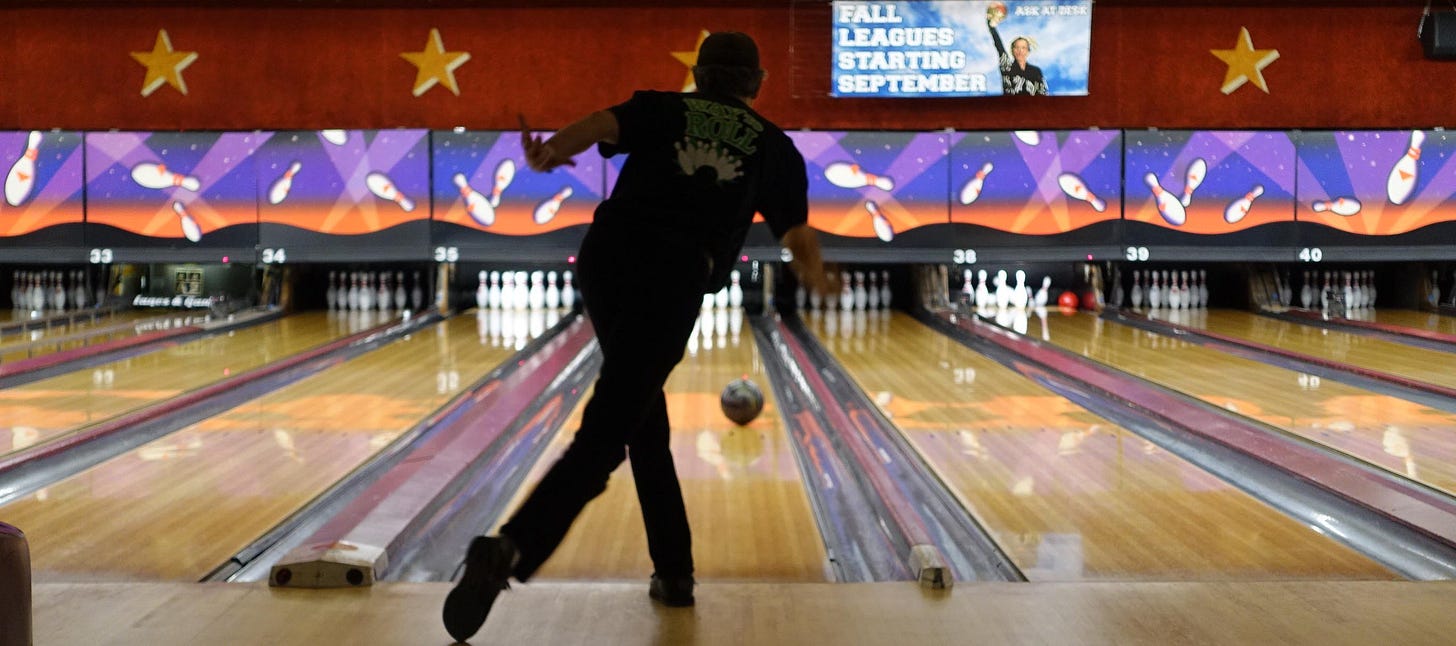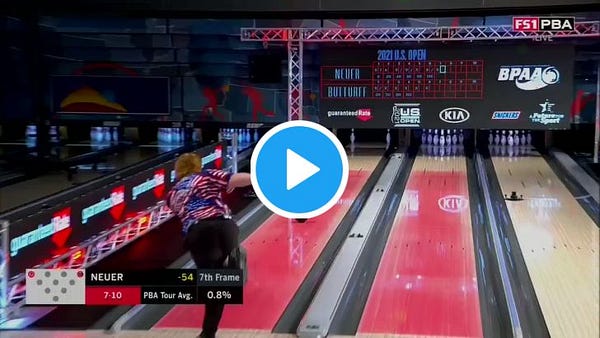Hello Readers and/or Bowlers,
Anyone who spends time hanging around with bowlers in America is bound to notice a tendency among many of them toward nostalgia. There’s a pretty common feeling that we’ve lost too many bowling alleys, and that league bowling isn’t the big thing it used to be, and that bowling as a sport gets too little respect.
Generalized nostalgia is not to be trusted. America wasn’t a better place in the 1960s and 1970s just because the great Chris Schenkel (b: 1923 in Bippus, Indiana) was calling the Pro Bowlers Tour on Saturday afternoons on ABC. And yet it probably is true that bowling in America used to be a lot better. That’s been my experience, anyway. The American Legion bowling lanes in Lowell, Ind., where I learned to bowl with my best friend Dan W., are long gone. I’ve read that there were about 12,000 bowling centers in the U.S. by the mid-1960s. Now there are about 5,000. Several years ago, my old friends Bill & Julie notified me that the American Legion lanes in their town of LaGrange, Tex. were up for sale, at an affordable price. Here was my chance to become a Texas bowling proprietor, they said. I did not possess that kind of courage. The place got turned into an antiques mart, last I heard.
I watched as my regular spot on Route 2 in Cambridge, once known as the Turnpike Bowladrome, was sold in 2017 to developers—and all of the vintage equipment, not to mention the “social capital,” to use Robert Putnam’s term, was destroyed to make room for a luxury housing complex. Many of the people I’d met in league bowling migrated in the next season to a place up in Malden that used to be called Town Line Ten Pin, later to be fancied up and re-named as Townline Luxury Lanes. The place had 48 lanes and was a fine venue for weeknight leagues. However, word reached me a few weeks ago that Townline is converting to “string pinsetters.” Why, why, why? Well, one can guess why. Pinsetting equipment is expensive, and it requires good mechanics to keep it running smoothly. Here’s how the owner of Townline explained his thinking recently to a bowling trade magazine:
“In Malden I looked at how much I was paying in labor, how much I was paying in parts every year, I looked at how much down time I was having for so many reasons,” he says. “I know the strings can pay for themselves in a few years, so I might as well do it now rather than later and get that under my belt.”
It reminded me of a discussion I once had in which I was trying to explain what the pointy-heads mean when they talk about “neoliberalism.” Think of what happened at my former bowling alley, I said. It was a small family-owned business. It brought together a peculiar mix of people who otherwise would never socialize with each other. A whole web of human relationships developed among the people who worked there and the people who bowled there. A guy starts out as a mechanic and 40 years later he’s the general manager. But in the end, there’s a much more profitable use for the land that the bowling alley occupies. All of the human values are secondary. Large economic interests demand a transformation. That’s how I think about neoliberalism: anything related to human community is secondary to the decisions of a few people who come along with money and power and are Thinking Big. In cities that means redevelopment for more expensive uses. In rural America it usually means deindustrialization. If your town is going to dry up and blow away, so be it. If your newspaper is going to lose all its journalistic talent (see last week’s news of the hollowing out of the Chicago Tribune), look jack, this is about business. You can quantify advertising revenue vs. reduced labor costs. You can’t calculate exactly what is lost when there aren’t good reporters poking around City Hall. After a while, the process begins to seem natural and inevitable, even as it spreads into properly non-commercial realms, such as education and health care. As William Davies put it recently in New Left Review, neoliberal capitalism sees markets as “the sole rational basis for material distribution,” while also “expanding the reach of market-based valuation into non-market spheres as a cultural norm.”
String theories
OK, I’ve never bowled on lanes with string pinsetters. But you know right away that it puts an end to regular league bowling. It becomes a different thing—a recreational amusement, not a sport. The key to picking up spares involves hitting pins so they interact the way you want them to, and then hoping for a little luck. Putting them on strings would seem to change everything. Not sure how it would affect the chances to convert the seven-ten split! Every once in a while you see video of one of those moments where perfect skill meets unusual random luck and you see something like this. (Click on ‘PBA Tour’ here, not the play arrow.)
Amazeballs
Bowling technology always changes, of course. There was a time when bowling balls were made of wood. And then along came the newfangled ball of hard black rubber. Now they have reactive resin coverstock and asymetric cores and they come with names like DV8 Hell Raiser Blaze. (I was using a ball during the Trump years called “Scandal.”)
Some years ago when I attended the Dick Ritger Bowling Camp (seeking that “Total Strike Feeling”), I was talking to a coach who testified to how much he’d learned about bowling balls from a guy named Mo Pinel. Mo had an engineer’s knowledge of physics and chemistry and had been at the forefront of technical innovations in bowling balls. In other words, he was part of the move in the 1980s and 1990s to alter the core of the ball to help the ball hook more aggressively to the pocket. I made a mental note of it and thought I’d try someday to talk to Mo Pinel.
I never did, but a talented magazine writer named Brendan Koerner did, and he ended up with a moving story for Wired magazine, published last month. Even if you don’t care a whit about bowling ball tech, you can appreciate the human story that Koerner found, which took a twist at the end that he did not foresee. Check out Brendan’s story here. The only thing I don’t like about it is the use of the word “amazing” in the title, because “amazing” is a tuckered-out word. It’s like a plastic house ball that just doesn’t bring any power to the pins. But. . . the story does amaze, if you read it.
Outré limits
A while ago a package came to me from my friend Josh of L.A. At first I saw the contents as delightfully outré bowling-themed ashtrays. But. . . they could just as well be hors d’oeuvres trays for a fine soirée. I don’t even think it’s just “nostalgia” that makes some of us respond to a certain kind of bowling iconography. But maybe it is. I mean, you know that bowling alleys used to have more character before they were turned into night-clubby scenes and “luxury lanes.” That bowling alley made famous by The Big Lebowski, by the way, represented a trend in bowling alley design that came to be known as “the California style.” The movie was set at Hollywood Star Lanes of East Hollywood. The place was torn down in 2002.







hmmm ... i bet those cool ashtrays would work well with a cigar ... and a glass of bourbon by their side
“So ball motion is one gyroscope operating in the field of a bigger gyroscope, which is the earth.” I think Mo Pinel found the missing cosmology of bowling.